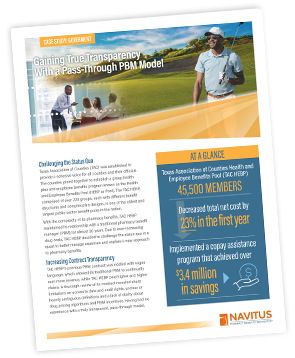Gaining True Transparency With a Pass-Through PBM Model: A Case Study
Are you getting the most transparent and affordable pharmacy benefit solution? If your pharmacy benefit manager (PBM) is not 100% pass through and transparent, you may experience hidden expenses.
According to a National Employer Survey, over 60% of employers say their prescription drug and medical spend is costly and unsustainable. The majority of these employers noted the lack of drug price transparency as the primary factor contributing to this issue, which is further intensified by the fact that traditional PBMs are highly motivated by rebate revenue.
For one plan, the complexity of its pharmacy benefits kept it with its traditional PBM for almost 20 years, despite its increasing Rx benefit costs.
Challenging the Status Quo
Texas Association of Counties (TAC) established a group health plan and employee benefits program known as the Health and Employee Benefits Pool (HEBP or Pool). With ever-increasing drug costs, TAC HEBP decided to challenge the status quo in a quest to better manage expenses and explore a new approach to pharmacy benefits.
Increasing Contract Transparency
TAC HEBP’s previous PBM contract was riddled with vague language, which allowed its traditional PBM to continually earn more revenue, while TAC HEBP paid higher and higher claims. A thorough review of its contract revealed sharp limitations on access to data and audit rights, unclear or heavily ambiguous definitions and a lack of clarity about drug pricing algorithms and PBM incentives.
Reducing Costs and Improving Health
Teaming up with Navitus, the Pool implemented several programs to help improve member access to prescription drugs and contain costs for both the plan and its members.
An expansion of 90-day prescriptions at retail and mail for maintenance medications created a larger network of participating pharmacies, providing added convenience for members
Utilization management programs helped ensure members had access to the most clinically appropriate, safest and most cost-effective medications
A copay assistance program was implemented for certain specialty drugs
By switching to Navitus and applying these cost savings solutions, TAC HEBP experienced a 23% decrease in total net cost in the first year.
Want to see more results? Download the case study to learn more.
With the complexity of its pharmacy benefits, TAC maintained its relationship with a traditional pharmacy benefit manager (PBM) for almost 20 years. However, due to ever-increasing drug costs, TAC decided to challenge the status quo in a quest to better manage expenses and explore a new approach to pharmacy benefits.
Having had no experience with a truly transparent, pass-through model, TAC didn’t realize how much more visibility into drug pricing and savings it could be getting.
Teaming up with Navitus, TAC implemented several programs to help improve member access to prescription drugs and contain costs for both the plan and its members.
How did they do it?
Navitus’ transformative, pass-through PBM model, with visibility down to the claim and invoice level, gleans insight into where drug spend is going to get more out of pharmacy benefits.
Stay Informed and Connected
Receive expert insights, healthcare tips, and important updates on pharmacy benefits, drug recalls, and more—straight to your inbox.
Navigating with a trusted partner
Now Available: 9th Annual Drug Trend Report
Our Drug Trend Report provides a clear view of the trends shaping pharmacy benefits today, along with strategies that are delivering real savings without compromising care.









